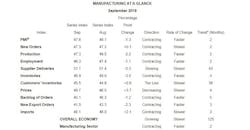ISM: Overall sentiment cautious regarding near-term growth
Economic activity in the manufacturing sector contracted in September, and the overall economy grew for the 125th consecutive month, say the nation’s supply executives in the latest Manufacturing ISM Report On Business.
“Comments from the panel reflect a continuing decrease in business confidence,” said Timothy R Fiore, chair of the ISM Business Survey. “September was the second consecutive month of PMI contraction, at a faster rate compared to August. Demand contracted, with the New Orders Index contracting at August levels, the Customers’ Inventories Index moving toward ‘about right’ territory and the Backlog of Orders Index contracting for the fifth straight month (and at a faster rate). The New Export Orders Index continued to contract strongly, a negative impact on the New Orders Index.
“Consumption (measured by the Production and Employment indexes) contracted at faster rates, again primarily driven by a lack of demand, contributing negative numbers (a combined 3.3-percentage point decrease) to the PMI calculation. Inputs—expressed as supplier deliveries, inventories and imports—were again lower in September, due to inventory tightening for the fourth straight month. This resulted in a combined 3.3-percentage point decline in the Supplier Deliveries and Inventories indexes.”
The September PMI registered 47.8%, a decrease of 1.3 percentage points from the August reading of 49.1%.
Other highlights from the report:
- The New Orders Index registered 47.3%, compared to the August reading of 47.2%.
- The Production Index registered 47.3%, compared to the August reading of 49.5%.
- The Employment Index registered 46.3%, compared to the August reading of 47.4%.
- The Supplier Deliveries Index registered 51.1%, compared to the August reading of 51.4%.
- The Inventories Index registered 46.9%, compared to the August reading of 49.9%.
- The Prices Index registered 49.7%, compared to the August reading of 46%.
Also, imports contracted slowed, ISM said. Overall, inputs indicate supply chains are meeting demand and (2) companies are continuing to closely match inventories to new orders. Prices decreased for the fourth consecutive month, but at a slower rate.
Miscellaneous manufacturing was among three industries reporting growth in September. Fabricated metal products, primary metals, transportation equipment and machinery were among 15 industries reporting contraction.
“Global trade remains the most significant issue, as demonstrated by the contraction in new export orders that began in July 2019,” Fiore said. “Overall, sentiment this month remains cautious regarding near-term growth.”
Here are some selected comments from respondents:
- “Second month in a row in which shipments have outpaced new orders.” (Computer & Electronic Products)
- “Continued softening in the global automotive market. Trade-war impacts also have localized effects, particularly in select export markets. Seeing warehouses filling again after what appeared to be a short reduction of demand.” (Chemical Products)
- “Business outlook remains cautious. Orders seem to be decreasing, but luckily not as sharp of a decrease as we were expecting.” (Transportation Equipment)
- “Chinese tariffs going up are hurting our business. Most of the materials are not made in the US and made only in China.” (Food, Beverage & Tobacco Products)
- “General market is slowing even more than a normal fourth-quarter slowdown.” (Fabricated Metal Products)
- “Demand softening on some product lines, backlogs have reduced, and dealer inventories are growing.” (Machinery)
- “Business has been flat for us. Year-over-year growth has slowed dramatically.” (Miscellaneous Manufacturing)
- “We have seen a reduction in sales orders and, therefore, a lower demand for products we order. We have also reduced our workforce by 10%.” (Plastics & Rubber Products)
- “Incoming sales are sluggish for this time of year.” (Furniture & Related Products)
- “Economy seems to be softening. The tariffs have caused much confusion in the industry.” (Electrical Equipment, Appliances & Components)

